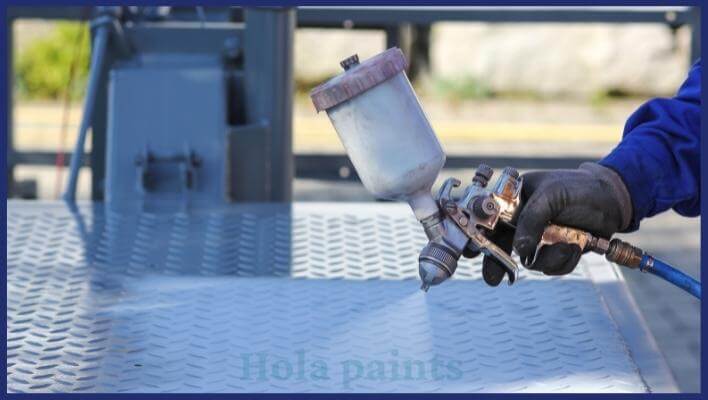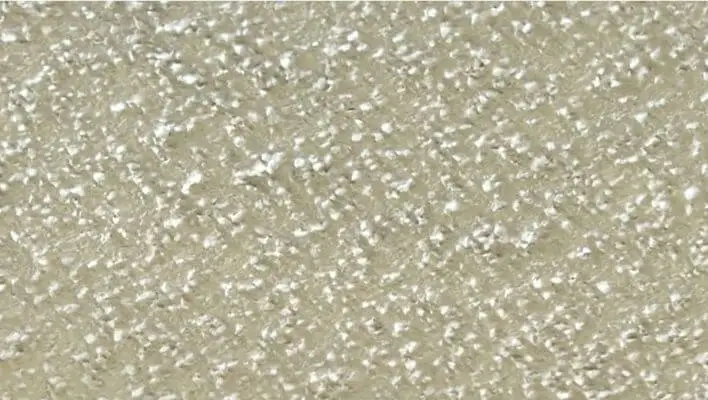Achieving a flawless, glass-smooth finish on a painted surface is the ultimate goal for any DIY enthusiast or professional painter. However, sometimes, instead of a nice, refined surface, it looks all bumpy and weird, like the skin of an orange. That’s what we call “orange peel” in the painting world. It’s not what you wanted, right? So, how to fix orange peel in paint?
To address minor “orange peel” imperfections, sand with P1200, use Glasurit 562-1602 Fine Polishing Compound, and complete with high-gloss polish. For major issues, fully sand and apply a new finish, and consider wet sanding for severe cases.
To fix orange peel in paint, you need to first figure out what causes orange peel in paint.
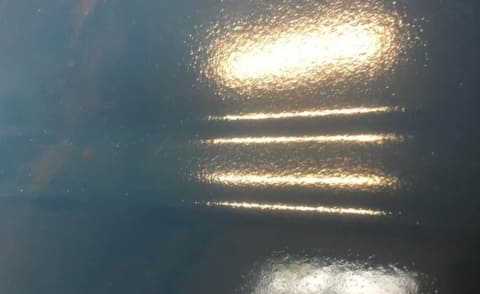
Table of Contents
- What Causes Orange Peel In Paint?
- Spray Gun Settings
- Temperature and Humidity
- Inadequate Surface Preparation
- Paint Viscosity
- How to Fix Orange Peel in Paint?
- Minor Orange Peel In Paint Job
- Major Orange Peel Spray Paint
- What Are The Best Spray Guns To Avoid Orange Peel Texture?
- Fuji Spray Semi-PRO 2 Spray Gun (HVLP System)
- ANEST IWATA LPH400
- DeVilbiss GTi Pro Lite
- 3M Accuspray ONE Spray Gun System
- Graco-Sharpe Paint Gun (HVLP FX3000)
- SATAjet 5000 B Spray Gun (Digital HVLP)
- Wrapping Up
- FAQs On how to correct orange peel paint job
- Q. Is it possible to improve the appearance of orange peel without sanding?
- Q. Is orange peel paint bad?
- Q. Can you buff out orange peel in paint?
- Martina Hitchcock
What Causes Orange Peel In Paint?
Orange peel in paint occurs when the surface of a freshly painted object or wall ends up resembling the texture of an orange peel, with small, bumpy imperfections. There are different aspects that could cause this problem:
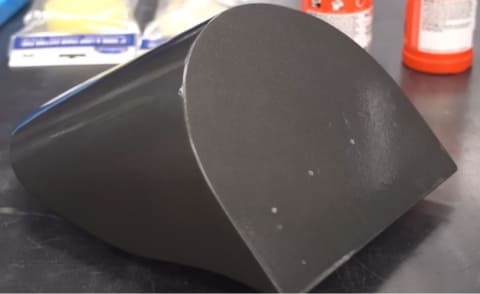
Spray Gun Settings
One of the most common orange peel reasons is improper spray gun settings. If your spray gun is set at too high a pressure, it can result in excessive paint being applied and uneven coat, leading to orange peel. Likewise, incorrect nozzle size and distance from the surface can also cause this issue.
Manage Paint Volume: To prevent excessive paint application and reduce the likelihood of orange peel, consider modifying the paint volume. This can be achieved by using a smaller paint tip or nozzle, decreasing the paint flow rate or tightening the fluid needle
Optimize Air Pressure: Another effective approach is to increase the air pressure within your spray gun. The adjustment promotes better atomization of the paint, leading to a finer spray pattern and minimizing the risk of overspray.
Temperature and Humidity
Environmental conditions play a significant role in paint application. Painting in high humidity or extreme temperatures could also lead the paint to dry too quickly or not bond properly, resulting in an uneven surface. Before starting your project, make sure that the surface and aerosol can temperatures are between 60-70°F, and the ambient air temperature falls within the same range. Keep humidity levels below 50% for an ideal working environment.
Are you familiar with the process of addressing sticky spray paint? We’ve already covered it for you; please check!
Inadequate Surface Preparation
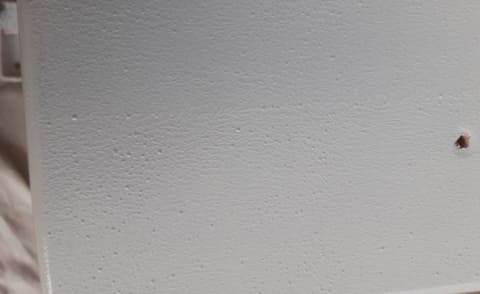
Insufficient sanding or cleaning of the surface before painting can leave contaminants or uneven spots that show through the paint, causing orange peel and air paint bubbling. To get a seamless texture on the car and eliminate the risk of orange peel, better surface preparation with the correct profile depth is important.
Paint Viscosity
The viscosity or thickness of the paint should match the specifications recommended by the manufacturer. Using paint that is too thick or thin can lead to paint crackle and texture issues. To resolve this problem, you can reduce the mixture’s thickness by slightly increasing the amount of thinning agent used.
How to Fix Orange Peel in Paint?
Before you start fixing the issue, assess the severity of the orange peel. Is it minor, covering only a small area, or is it extensive and covers the entire surface? The approach to fixing it will depend on the severity.
Minor Orange Peel In Paint Job
1. Sand with P1200 Grit Sandpaper

To address minor orange peel imperfections in your paint, begin by using P1200 grit sandpaper wrapped around a sanding block or a soft foam sanding pad. Lightly moisten the sandpaper or the surface with a spray bottle to create a lubricating film of water. Employ gentle, even motions; circular or back-and-forth while sanding to avoid damaging the paint.
Keep both the sandpaper and the metal surface wet throughout to prevent heat buildup. Continue sanding until the paint’s orange peel texture is smoothed out, leaving a surface that feels even to the touch.
Note: As per my experience, sanding is also very helpful in fixing spray paint drips.
2. Polishing Compound
Apply a fine polishing compound like No.7 Rubbing Compound. Work by parting the sections, giving moderate pressure in a circular pattern so that the compound is evenly spread. Remember to keep following the guide given by the manufacturer for application and buff the surface until it becomes sleek and glossy.
3. High-Gloss Polish
Finish the process by applying a high-gloss polish to restore the shine and luster of the paint. I would recommend Meguiar’s M10508 ultra finishing polish because I found it quite effective in achieving a high-gloss finish on automotive paint.
This polish is designed to remove fine swirls and imperfections, making it an effective choice for addressing minor orange peel issues. Its advanced formula is also easy to work with and provides a deep, even shine. For more insights on achieving the perfect Orange Peel texture in residential finishes, refer to Graco’s expertise. Visit Graco’s website for detailed guidance on equipment selection and techniques.
Major Orange Peel Spray Paint
If the orange peel is extensive or covers a large area, you need to opt for major fixes:
1. Full Sanding
Start by fully sanding the entire surface with a lower grit sandpaper, such as P800, to remove the existing paint and orange peel. This is a coarse sandpaper, and it’s used to level out the texture.
After using the coarse sandpaper, gradually move to finer grits, such as P1000, P1200, and finally P1500. Each finer grit sandpaper will help refine the surface texture further. Be sure to sand in a consistent, even motion to avoid creating any uneven patches on the surface.
2. Wet Sanding
Consider wet sanding with the finer grits. Wet sanding involves using a lubricant, like soapy water, to reduce friction and achieve a seamless finish. This method is especially useful for eliminating stubborn orange peel and reducing the risk of scratching the paint.
3. Apply a New Finish
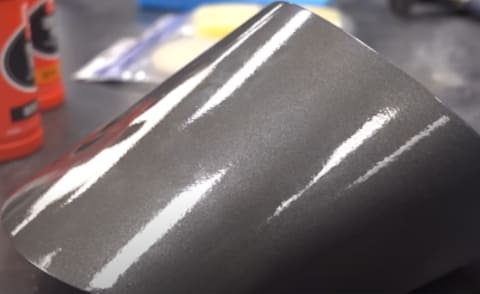
After sanding, I recommend using a quality automotive primer such as Dupli-Color ECP199 for a smooth base. Apply the primer as a base.
Then use a reputable automotive basecoat paint in thin, even coats. Protect with a clearcoat, like Sherwin-Williams Finish1 FC720, for protection and gloss.
For wet sanding and polishing, use 3M 3000-grit sandpaper and Meguiar’s Ultimate Compound for a flawless look.
What Are The Best Spray Guns To Avoid Orange Peel Texture?
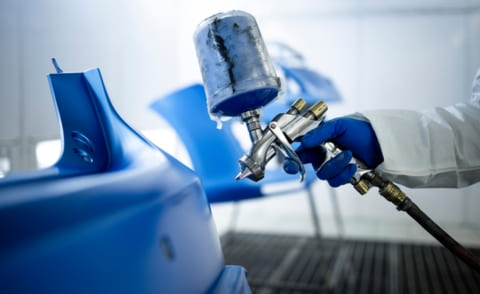
The choice of spray gun can greatly influence the final result. I have used different high quality spray guns in my car painting projects and shared 3 of the best spray guns that can help you avoid orange peel texture:
Fuji Spray Semi-PRO 2 Spray Gun (HVLP System)
The Fuji Spray Semi-PRO 2 HVLP system boasts exceptional atomization, ensuring a beautifully even appearance. Its adjustable air pressure controls allows you to set the adjustments to your paints and surfaces, reducing the chances of orange peel texture.
ANEST IWATA LPH400
Another popular choice from ANEST IWATA, the LPH400 HVLP spray gun is important for car paint orange peel issues. Its high-quality atomization creates fine paint particles for a smooth finish, minimizing orange peel texture. With adjustable settings for air pressure, fluid flow, and fan pattern, users can fine-tune the gun to achieve precise results. Additionally, HVLP technology reduces overspray, optimizing paint application efficiency. This spray gun is a valuable asset for reducing overspray, auto refinishing, and aiding in the quest for flawless, professional-looking paint finishes.
DeVilbiss GTi Pro Lite
The GTi Pro Lite offers several nozzle sizes and configurations for handling different paint types and finishes.
3M Accuspray ONE Spray Gun System
This spray gun system offers interchangeable atomizing heads, making it suitable for a range of paint viscosities.
Graco-Sharpe Paint Gun (HVLP FX3000)
The Graco-Sharpe 288880 HVLP FX3000 Spray Gun, a favored choice, excels at delivering a neat end result. With consistent spray patterns and adjustable air pressure controls, it’s a dependable tool for eliminating orange peel texture and ultimately getting professional results.
SATAjet 5000 B Spray Gun (Digital HVLP)
The SATAjet 5000 B HVLP gun is renowned for its unmatched atomization and efficient paint transfer, ensuring a top-tier finish. The digital control and pressure gauge allow precise air pressure adjustments, guaranteeing ideal settings to prevent orange peel texture and achieve high-quality results.
Wrapping Up
Remember that preventing orange peel in the first place by paying attention to the factors mentioned earlier is the best approach. However, if it does occur, this guide on how to fix orange peel in paint can help you achieve a gentle coating on your painted surfaces. Always take your time, follow proper techniques, and ensure a clean and controlled environment for the best results.
FAQs On how to correct orange peel paint job
Q. Is it possible to improve the appearance of orange peel without sanding?
Yes, you can reduce orange peel to some extent using a compound, although it is advisable to begin with sanding, preferably using P1500 or P2000 grit sandpaper, before applying the compound.
Q. Is orange peel paint bad?
Orange peel in paint is not inherently bad, but it’s an undesirable texture caused by improper paint application, leading to a bumpy or dimpled surface after painting. It can affect the aesthetic quality of the paint job and may require corrective measures for a sleek appearance.
Q. Can you buff out orange peel in paint?
Buffing out orange peel in paint is achievable with the use of a cutting compound, often employed for removing scratches from vehicles. Applying approximately 32 fluid ounces (950 mL) of compound should suffice to address orange peel on a typical mid-sized 4-door vehicle.

Martina Hitchcock
Martina Hitchcock is a versatile author with expertise in different fields. As a paint sprayer expert, she has in-depth knowledge of paint spraying techniques, tools, and equipment. Martina is also an experienced home remodeler who has worked on various projects, including kitchen and bathroom renovations, flooring installations, and room additions. Her knowledge of home improvement and remodeling is extensive, and she enjoys sharing her insights and tips with readers. You can follow her on Facebook.

